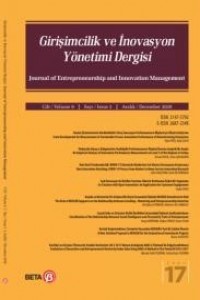Determination of Features Used in The Global Entrepreneurship Monitor Through Artificial Intelligence
Determination of Features Used in The Global Entrepreneurship Monitor Through Artificial Intelligence
To determine the items that need to be concentrated in order to increase the development levels of the countries in the GEM report with artificial intelligence techniques. At the same time, it is aimed to examine the situation of Turkey. Methodology: The data were taken from the GEM report and the Adaptive Neuro-Fuzzy Classifier with Linguistic Hedges method was used. Findings: The most important factor affecting the level of development in terms of entrepreneurship was determined as "Government policies: Taxes and bureaucracy". Practical Implications: Countries that want to develop in terms of entrepreneurship should first give priority to developments within the scope of "Government policies: Taxes and bureaucracy". Originality: In this study, artificial intelligence techniques, which are very popular today, were used rather than the methods commonly used in the field of social sciences.
Keywords:
The Global Entrepreneurship Monitor Entrepreneurship Ecosystem, Artificial Intelligence, Adaptive Neuro-Fuzzy Classifier with Linguistic Hedges,
___
- Amoros, JE., Cristi, O., & Naude, W. (2021), “Entrepreneurship and Subjective Well-Being, Does The Motivation To Start-Up A Firm Matter?”, Journal of Business Research, 127, 389-398. Aydemir, Ö. (2017), “Determining The Effective Features in Sequential Forward Feature Selection Algorithm”, Dicle University Journal of Engineering, 8(3), 495-501. Bilginer, FG. (2017), “Within The Framework of The Global Entrepreneurship Index The Global Entrepreneurship Development in Turkey, A Theoretical Perspective”, Journal of International Trade and Economic Researches, 1(1), 29-46. Canayaz, M., & Demir, M. (2017), “Feature selection with the whale optimization algorithm and artificial neural network”, International artificial intelligence and data processing symposium (IDAP). IEEE, Malatya, Turkey, 16-17 September 2017, pp. 1-5. Turkey. Carree, M., van Stel, A., Thurik, R., & Wennekers, S. (2002), “Economic Development and Business Ownership, An Analysis Using Data of 23 Oecd Countries in The Period 1976–1996”, Small Business Economics, 19(3), 271-290. Çelik, C., & Bilge, HŞ. (2015), “Feature Selection with Weighted Conditional Mutual Information”, Journal of the Faculty of Engineering and Architecture of Gazi University, 30(4), 585-596. Çetişli, B. (2006), “Using Neuro-Fuzzy Classifier with Lingustic Hedges For Feature Selection”, Eng&Arch.Fac. Eskişehir Osmangazi University, 19(2), 109-130. Doğan, Y. (2020), “Improvement of Recurrent Deep Neural Networks Algorithm by Feature Selection Methods and Its Usage of Automatic Identification System Data Evaluated as Time Series”, Journal of the Faculty of Engineering and Architecture of Gazi University, 35(4), 1897-1912. Eskidere, Ö. (2012), “A Comparison of Feature Selection Methods for Diagnosis of Parkinson’s Disease From Vocal Measurements”, Sigma, 30, 402-414. Fırat, M., Yurdusev, MA., & Mermer, M. (2008), “Monthly Water Demand Forecasting By Adaptive Neuro-Fuzzy Inference System Approach”, Journal of the Faculty of Engineering & Architecture of Gazi University, 23(2), 449-457. GEM (2013). Global Entrepreneurship Monitor 2013 Global Report. Available at, http://www.gemconsortium.org/docs/3106/gem-2013-global-report (accessed December 15, 2020). GEM (2016). Global Entrepreneurship Monitor 2015-16 Global Report. Available at, https://www.gemconsortium.org/report/gem-2015-2016-global-report (accessed December 15, 2020). Hamet, P., & Tremblay, J. (2017), “Artificial Intelligence in Medicine”, Metabolism, 69, 36-40. Contreras, I., & Vehi, J. (2018), “Artificial Intelligence for Diabetes Management and Decision Support, Literature Review”, Journal of Medical Internet Research, 20(5), 1-21. Huang, MH., & Rust, RT. (2021), “A Strategic Framework for Artificial Intelligence in Marketing”, Journal of the Academy of Marketing Science, 49(1), 30-50. Karadeniz, E., & Özdemir, ÖY. (2009), “Entrepreneurial Activities in Turkey, an International Comparison Using Gem Data”, Bogazici Journal, Review of Social, Economic and Administrative Studies, 23(1-2), 19-36. Keleş, A.E., & Keleş, M.K. (2018), “Prediction of Employee Leadership Perception in Construction Managementusing Feature Selection with Genetic Algorithm”, Cukurova University Journal of the Faculty of Engineering and Architecture, 33(4), 97-110. Legatum Enstitüsü (2013), The Legatum Prosperıty Index. Available at: http://www.prosperity.com/#!/?aspxerrorpath=%2FRanking.aspx (accessed December 15, 2020). Pençe, İ., & Çetişli, B. (2013), “Handwriting Character Modeling with Implicit Curves and Classification”, Sigma, 5, 1-7. Phadikar, S., Sil, J., & Das, AK. (2013), “Rice Diseases Classification Using Feature Selection and Rule Generation Techniques”, Computers and Electronics in Agriculture, 90, 76-85. Pan, Y., & Zhang, L. (2021), “Roles of Artificial Intelligence in Construction Engineering And Management, A Critical Review And Future Trends”, Automation in Construction, 122, 1-21. Sağbaş, EA., Gökalp, O., & Uğur, A. (2019), “Feature Extraction Based on Distance Ratio and Selection with Genetic Algorithms For Facial Expression Recognition”, Data Science, 2(1), 19-29. Şengül, F. (2022), “Girişimcilik Ekosistemi Dinamikleri ve Önceliklendirilmesi”, MS thesis, Karabük University, Institute of Graduate Studies, Karabük. Zheng, W., Zhu, X., Wen, G., Zhu, Y., Yu, H., & Gan, J. (2020), “Unsupervised Feature Selection By Self-Paced Learning Regularization”, Pattern Recognition Letters, 132, 4-11. Pehlivanoğlu, F, and Kayan K. (2019), "Türkiye’de girişimcilik: Mevcut durum analizi ve çözüm önerileri." Kırklareli Üniversitesi İktisadi ve İdari Bilimler Fakültesi Dergisi 8.1 : 58-78.
- ISSN: 2147-5792
- Başlangıç: 2012
- Yayıncı: Beta Basım Yayım Dağıtım A.Ş.
